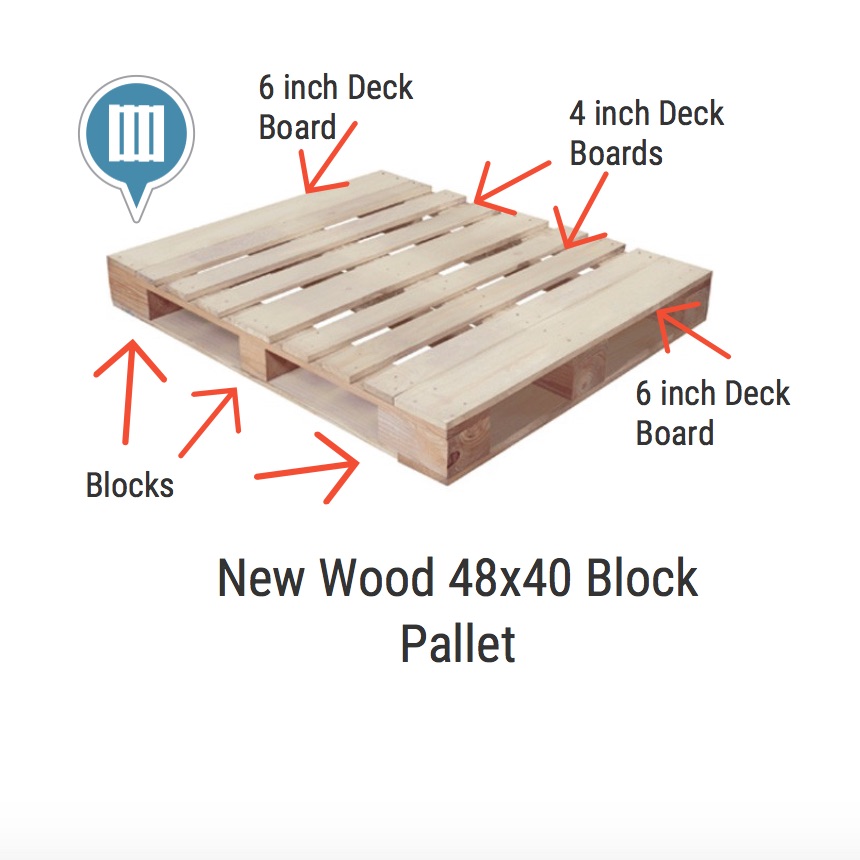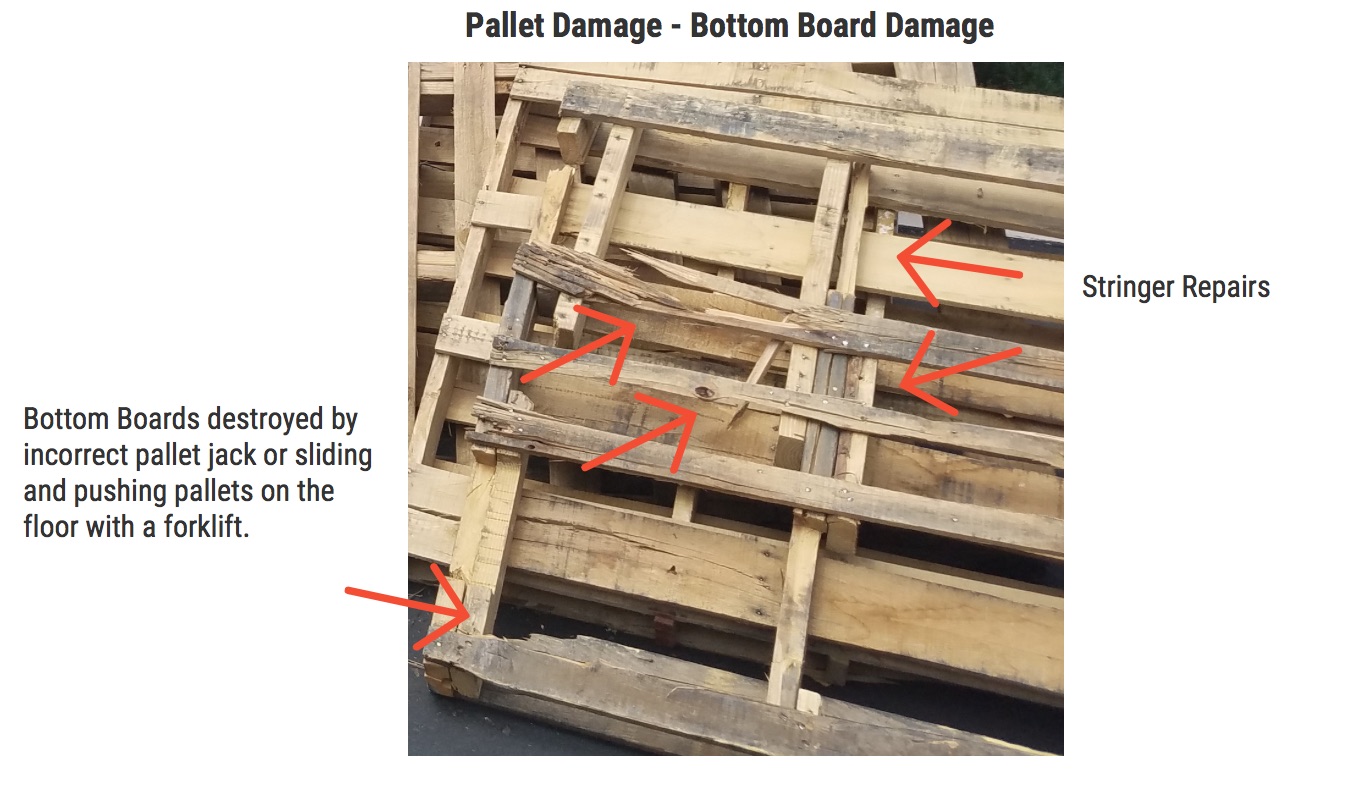Common Pallet Damage
Common Pallet Damage

Buy Pallets, Sell Pallets, and Find FREE Pallets at Repalletize
Click here to search the map
Share Your Pallet Buying And Recycling Experience With Your Friends
Common Pallet Damage
To get a true understanding of common pallet damage you first need to know common types of pallets and the parts to a pallet. In addition, knowing how pallets are used and the correct way to use a pallet will help prevent damage to pallets. Once reviewing these topics understanding pallet damage is easier. Knowing and understanding pallet logistics and common pallet damage will help your company increase employee safety, reduce pallet costs, and increase profits.
Common pallets
Block Pallet
Using square blocks on the corners, sides, and middle of the pallet create a framework for the boards to attach to. Deck boards and bottom boards connect to the blocks. Using blocks creates a 4-way entry pallet, that can be entered by a forklift on all four sides. Block pallets are considered heavy duty and can carry more weight than other pallets. Block pallet prices are generally more expensive than other types of pallets.

CHEP Pallet
If you come across painted blue block pallets you can almost be sure they are CHEP pallets. CHEP pallets are block pallets that are painted blue and have a white C stenciled on the side. There is also a stamp that says ?Property of CHEP call to return?. Repalletize.com is authorized to return CHEP pallets. If you have extra CHEP pallets give us a call and we will return them.

Stringer Pallet
The standard size pallet in the industry is a GMA 48x40-inch pallet. A stringer pallet has 2x4-inch boards that run the length of the pallet on the sides and middle. If there are notches on the side stringers then a forklift can enter from the side and the pallet would be considered a 4-way entry pallet. Material handlers use stringer pallets, as they are very efficient. Stringer pallets are cost effective and a popular shipping platform. There are many places to buy stringer pallets.
Plywood Pallet
Plywood pallets are becoming more popular although they are less recyclable. This pallet typically has a solid piece of plywood on top and blocks at the corners, sides and middle. Some plywood pallets have deck boards on top that are made from plywood. These pallets are very hard to recycle.

Pressed Wood Pallet
Pressed wood pallets are made from particles of wood or chips of wood that are pressed to form a pallet. These pallets are usually nestable which means they stack together. These pallets do not have nails and are constructed in one piece. Pressed wood pallets are also export ready meaning that they qualify for ISPM Export ready. These pallets price point is similar to a stringer pallet.
Skid
Skids are pallets that do not have bottom boards. Skids just have top deck boards and stringers or blocks. These pallets can be useful if you are not using pallet racks.

Wing Pallet
A wing pallet has deck boards that extend past the stringer boards. These pallets can be extra sturdy and hold more weight but they are also susceptible to damage.
New Pallet
New pallets are pallets made from virgin timber or new lumber. New pallets are typically built on demand. Prices of new pallets are relatively higher than the used pallet or recycled pallet.
Recycled Pallet or Used Pallet
These pallets can be a one time use pallet or multiple use pallets. These pallets have typically been repaired due to damage or reused from its original shipping destination. Quality can be an issue when using a recycled or used pallet. Not all recycled pallets will be the same.
Custom Pallet
A pallet manufacturer typically designs custom pallets for a client that is shipping an odd sized product. Custom pallets can help protect the materials or freight that is being shipped. Custom pallets are great for companies that produce high end products.

Define pallets parts
Stringers
These boards are the length of the pallet. Typically they measure 48-inches. Stringers are usually 2x4-inch boards.
Deck Boards
There are typically 7 deck boards on a GMA pallet. Deck boards are 1x4-inch boards except the lead boards which are 1x6-inch boards.

Lead Boards
Lead boards are the deck boards at the front and end of the pallet. Lead boards should be a 1x6-inch board according to GMA specifications.
Bottom Boards
There are 5 bottom boards on a pallet the lead boards on the bottom are 1x6-inch and the middle 3 bottom boards are 1x4-inch boards.
Blocks
Blocks are the square or rectangle blocks usually 4x4-inch or 4x6-inch that are used to construct the pallet.

4-way entry
: Is a term used for a pallet that has forklift entry on all four sides.

2-way entry
Is a term used for a pallet that has forklift entry on two sides.
How A Pallet Is Used
Storing and Shipping Products on Pallets
Pallets are used to store and ship products. The items place on a pallet could be small boxes, Gaylord Boxes, bulk bags or super sacks, drums, or other containers. If the pallet is not large enough then the products could be damaged. The surface area of a pallet is called the footprint. Most pallets will also have a weight capacity. Make sure you do not add to much weight to the pallet or the deck boards may bend or crack. Storing pallets in pallet racks are what most warehouses do.
Common Pallet Damages Examples
Excess Weight Damage
Putting to much weight on a pallet can cause damage to the stringers and deck boards. Deck boards can break, crack, and bend or warp.
Forklift Damage At Pallet Entry Points
If the forklift driver is not experienced they can strike the pallet with the fork at the entry points. This can cause stringers, blocks, or deck boards to splinter and crack.
Pallet Jack Damage To Pallet Bottom Boards
If an operator of a pallet jack tries to lift the pallet jack while the pallet jack is on the bottom boards it will crack the bottom boards, damage the deck boards and possibly damage the stringers. Be very careful with a pallet jack.

Dropping Pallet Damage
If you drop a pallet it can crack or boards could break.
Entering Pallet Too Fast
If you enter the pallet to quickly then you are more likely to het the forks into the pallet or worse damage the product.
Half-Entry Into Pallet
If you lift a pallet when the forks are half way into the pallet the pallet can break in half. This can be extremely dangerous if the pallet is heavy. It can cause employee injury and possibly death.
Pushing Pallet With Forklift
Do not push pallets while sitting on the warehouse floor. This will damage the bottom boards.

Stringers
Lead deck boards should be flush with the stringers to avoid damage. If the stringers are exposed on top wood can break off and a repair will be needed. Product damage is very common if lead deck boards are not covering the stringers.
Deck Boards
Deck boards crack all the time. They can also bend and warp. Deck boards are also prone to splintering when hit with a forklift. Make sure deck boards are secured with good nails or fasteners. A loose deck board can cause major problems.

Lead Boards
Lead boards are the deck boards at the front and end of the pallet and are important to covering the end of the stringer. If the lead boards are damaged replace immediately because that is a major source of product damage.
Bottom Boards
Bottom boards are often damaged by pallet jacks. Since deck boards are underneath the pallet and can not be seen damages can go un noticed. Make sure you check the 5 bottom boards.
Blocks
Blocks are the square or rectangle blocks and should be replaced if pieces of wood are missing. Check your blocks.
Pallet Damage Leads To Product Damage
Products are more likely to get damaged if the pallet is damaged. Once the pallet integrity is compromised the product is at risk. Make sure you keep your products in boxes, shrink wrapped, have pallet guards, pallet corner protectors and other items to keep your product safe.
Solutions For Preventing Pallet Damage
Sorting Pallets
Sorting pallets will help you find the right size pallet for your products when shipping them. Sorting pallets will also help you keep the pallets in good condition when you are not using them. See our Sorting Pallets Guide Here .
Stacking Pallets
Stacking pallets is important if you have products on the pallets or if they are empty pallets. Stacking pallets correctly will keep your employees safe. Keep your pallets stacked correctly. See our full guide to Stacking Pallets Correctly Here.

Pallet Guards
Here is a product you may find useful in keeping pallets in good condition. pointGUARD Pallet Protection Products
Training Videos
Please view all of our training videos here at YouTube. View some more info at www.FreeRecyclingQuotes.com
Safety Tips
Please view our Safety Tips Here.